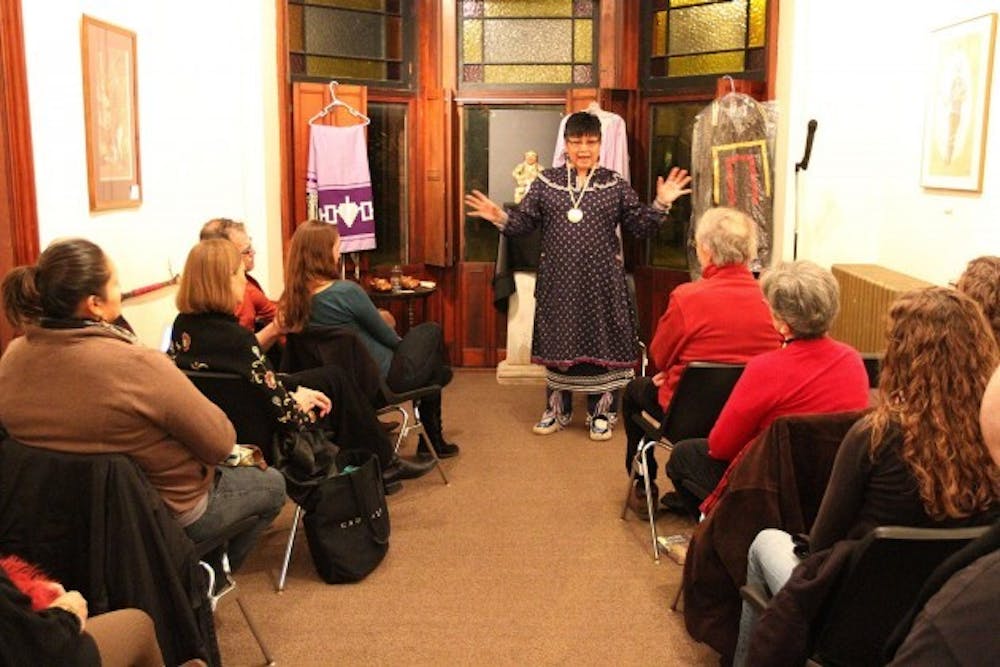A small and eager group sat huddled together, as an elder weaved stories relating to many different aspects of life.
People migrated to the C.G. Jung Center on Jan. 15 to listen to Ronnie Reitter weave the traditional tales of her native community. Reitter, a Seneca storyteller of the Wolf Clan,shared Haudenosaunee oral traditions that explain the values and beliefs of her people.
Reitter grew up in a foster home in upstate New York but at the age of 44, she felt it was time to reconnect with her past. After returning to the Cattaraugus Reservation, Reitter became genuinely interested and very involved with the teaching of traditional arts and storytelling of her people.
"I think it was just that point in my life where I was ready for it, opened [up] for it," Reitter said.
These stories demonstrate the grounding in nature and the spirituality of the universe. Every story has a captivating meaning behind it.
The archetypal myths Reitter tells of her people belong to the land they call Turtle Island or what others recognize as North America. The Haudenosaunee people refer to North America as Turtle Island to convey the meaning of the land being inhabited rather than discovered by Europeans. The name comes from "Sky Woman," the Haudenosaunee creation story in which Sky Woman fell from the Sky World and landed on a turtle's back.
This tale exemplifies the significance of the Sky World, which is where the Haudenosaunee people want to end up. The Sky World is a place of good spirits far above the water and clouds that cover Earth.
After her tales, audience members were able to give their thoughts on each story. A woman in the audience shared a story of her daughter who was unable to conceive children. After numerous failed attempts, the mother gave her daughter a turtle after being inspired by the Sky Woman story and shortly after found out that she was pregnant.
"We always say when you're doing something, you have to use the presence of the good mind," Reitter said. "Whether I'm storytelling, whether I'm sewing, whether I'm cooking for my family, it's all about having those good thoughts and a good mind that goes into it."
The second tale Reitter told was about the importance of equality. The story tells of a beautiful cornhusk woman who overheard a compliment causing her vanity level to rise. The woman's newfound pride and strong self-confidence reflected in the way she treated people, and after numerous threats from a disappointed chief, he punished her by removing her face and the faces of the rest of the cornhusk people to demonstrate equality among all. This specific tale shares the importance of being of a good mind and a group mentality, instead of being judgmental based on physical appearance.
Reitter isn't only known for her astonishing storytelling but her handmade cornhusk dolls as well. These dolls are made in relation to the story of the cornhusk woman.
"With cornhusk, I collect the husk from the harvest time and I usually bleach them out, dry them, and when I'm ready to make a doll, they have to be soaked in warm water for a few minutes to make them pliable," Reitter said. "It's just a technique that the elders taught me."
Reitter also designs her own outfits. She creates lady outfits, ribbon shirts and shawls that are common in the Haudenosaunee traditions.
The Haudenosaunee people believe in being kind to one another and sharing what they have. The final tale, "How Raven Stole the Tide," shows the importance of this. In the legend, an old lady prevents the people from gathering food until the raven comes and virtuously sabotages her method. This tale, like the previous one, also represents the Haudenosaunee belief in responsibility rather than a higher power.
Reitter has spoken at various schools ranging from kindergarten right up through 12th grade, senior citizens' groups and organizations throughout New York, such as Girl Scouts. Every single tale she tells reflects her native culture and each contains many lessons.
"I would hope that they would walk away with maybe a different perspective of native people. Most of the stories are a teaching tool, so I guess I would like to think that everybody can learn something," Reitter said
Email: arts@ubspectrum.com





